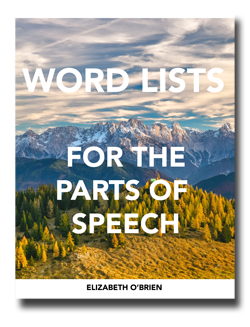Download your free grammar guide here.
Download your free grammar guide here.
Here's a list of conjunctions.
Here's a list of conjunctions.
- Home
- Word Lists
- List of Conjunctions
You might know the definition of a conjunction, but seeing this list of conjunctions will help you sear that definition in your mind.
Remember that conjunctions are words that join two or more words, phrases, or clauses.
There are three types of conjunctions (coordinating, subordinating, and correlative), and we'll look at examples of all of them here. Are you ready? Let's get started.
1. List of Coordinating Conjunctions
Coordinating conjunctions join sentence elements that are the same. They can join words, phrases, and clauses.
cookies and milk (joining words)
into the house and out the door (joining phrases)
He came and she left. (joining clauses)
There are only seven of these, and they're easy to memorize if you use the mnemonic device FANBOYS.
For, And, Nor, But, Or, Yet, So
Sentence diagrams are little pictures of sentences. They help us to see the grammatical relationship between words in a sentence.
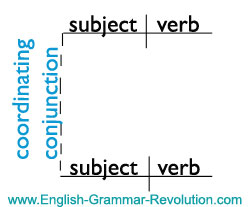
This sentence diagram shows us that coordinating conjunctions connect two or more sentence elements. The coordinating conjunction goes on a dotted, vertical line between the things that it connects.
The conjunction in this diagram is connecting two independent clauses. We call this type of sentence a compound sentence.
2. List of Subordinating Conjunctions
Subordinating conjunctions are conjunctions that join dependent adverb clauses to independent clauses.
I will eat broccoli after I eat this cookie.
I will eat broccoli = independent clause
after I eat this cookie = dependent adverb clause
after = subordinating conjunction introducing the adverb clause
There are many subordinating conjunctions, so keep in mind that this list doesn't include all of them! A WHITE BUS is a way to help you memorize some of the subordinating conjunctions.
A after, although, as, as if, as long as, as much as, as soon as, as though
B because, before
E even if, even though
F for
I if, in order that, in case
L lest
O once, only if
P provided that
S since, so that
T than, that, though, till
U unless, until
W when, whenever, where, wherever, while
You can see that these kinds of conjunctions connect dependent clauses (also called subordinate clauses) to independent clauses just by looking at the sentence diagram!
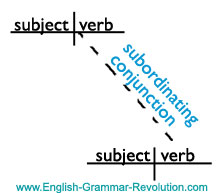
The subordinating conjunction goes on a dotted line between the two clauses. The top clause is an independent clause and the bottom clause is a dependent clause. We call this kind of sentence a complex sentence.
Would you like to download these word lists?
3. List of Conjunctions - Correlative Conjunctions
You don't hear too much about these kinds of conjunctions, and that's partly because we don't use them very much. They actually do the same thing that coordinating conjunctions do except that they are always used in pairs.
This cookie contains neither chocolate nor nuts.
both...and
either...or
neither...nor
not only...but also
whether...or
Here's a sentence diagram of the correlative conjunction both…and.
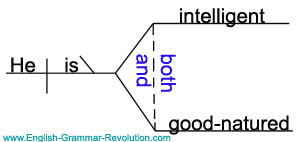
Did you notice that it's diagrammed in the same way that we diagrammed our coordinating conjunction above? I thought you would. You're so smart.
Conjunction or Preposition?
There's one very important thing to remember when it comes to word lists like this list of conjunctions: many of the words on this list can also act as other parts of speech.
That's right—many of these words aren't always conjunctions!
In order to know whether or not one of these words is a conjunction, you need to look at it in the context of a sentence. When you do that, you can ask yourself is this word connecting words, phrases, or clauses in this sentence? If the answer is yes, then it's a conjunction. If the answer is no, then it's acting as another part of speech in that particular sentence.
Let's check out an example. Look at these two sentences that both contain the word for. In one sentence, for is a conjunction, and in the other, it's not. Can you tell which is which?
A. I'm looking for bananas.
B. He felt energized, for he had just won the competition.
What do you think? Which sentence is using for as a conjunction?
A. I'm looking for bananas. (preposition)
B. He felt energized, for he had just won the competition. (conjunction)
If you said sentence B is using for as a conjunction, you are correct. In sentence B, for is connecting the two clauses he felt energized and he had just won the competition.
Now let's look at sentence A. In this sentence, for is a preposition. It's in the prepositional phrase for bananas.
Conjunctions don't connect single words to sentences; they connect words to other words, phrases to other phrases, and clauses to other clauses.
It might seem to you that for should be a conjunction in sentence A because it's "connecting" the noun bananas to the rest of the sentence, and in a way, that is correct. However, that's the job of a preposition! Prepositions show the relationship between a noun or a pronoun and the rest of the sentence. Prepositions are kind of like special noun connectors. I like to think of them as noun hooks.
Conjunctions, on the other hand, don't connect single words (like nouns) to sentences; they connect words to other words (cookies and milk), phrases to other phrases (into the room and to the left), and clauses to other clauses (I know the answer, but he doesn't).
Let's make this concept visual by comparing the sentence diagrams of a coordinating conjunction and a preposition.
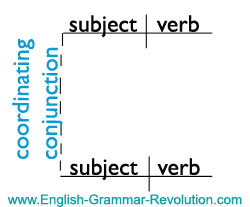
Notice that the conjunction is joining a clause to another clause. There is a clause above and below the conjunction.
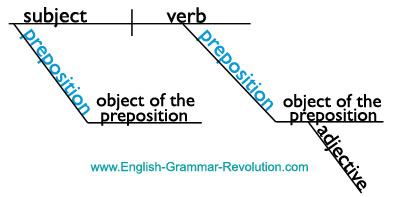
Notice that the preposition is "connecting" a word (a noun called "the object of the preposition") to the rest of the sentence. It has the special job of showing us how the noun relates to the rest of the sentence.
I hope that helps! If you're ever struggling to figure out if a word is a conjunction or not, I would strongly suggest looking up the word in a dictionary.
For example, you can see that in Merriam-Webster's definition for for, they show you definitions and examples for the word as a preposition and as a conjunction! This can be really helpful when you can't figure out whether a word is a conjunction or another part of speech.
Summary
Let's review what we covered on this page!
- Conjunctions join words, phrases, or clauses.
- There are three types: coordinating, subordinating, and correlative.
- Words on the list of conjunctions can also function as other parts of speech. When they're not acting as conjunctions, they're often acting as prepositions.

Hello! I'm Elizabeth O'Brien, and my goal is to get you jazzed about grammar.
Our Free Guide Gives You A Fun Way
To Teach And Learn The Basics v

Elizabeth O'Brien is the creator of Grammar Revolution.
Her lessons are guaranteed to give you more confidence in your communication skills and make you smile. :)
This is original content from https://www.english-grammar-revolution.com/list-of-conjunctions.html
